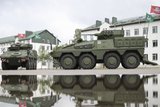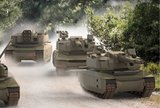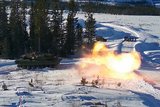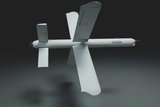US Army tests integration of upgraded PAC-3 MSE missile with LTAMDS
A Patriot PAC-3 Missile Segment Enhancement. (Photo: Lockheed Martin)
The US Army has conducted integration flight trials between an improved Patriot Advanced Capability – 3 Missile Segment Enhancement (PAC-3 MSE) and the Lower Tier Air and Missile Defence Sensor (LTAMDS).
Lockheed Martin announced that the PAC-3 MSE, alongside the Cost Reduction Interceptor (CRI), “successfully” detected, acquired, tracked and engaged an advanced Tactical Ballistic Missile (TBM) during a demonstration in the White Sands Missile Range, New Mexico. The interceptors were shot in a ripple configuration.
Aligned with the branch’s plans to modernise the Integrated Air and Missile Defense (IAMD) architecture, the test validated enhancements carried by the company
Already have an account? Log in
Want to keep reading this article?
More from Land Warfare
-
Germany signs multi-billion-dollar deals for 6x6 CAVS and GDELS Eagle vehicles
The order is a further boost for the Common Armoured Vehicles System programme which has notched notable successes in the past 12 months. The first vehicle, made in Finland, will be delivered next year with local production expected to ramp up in 2027.
-
![Rheinmetall and KNDS tank tie-up narrows trans-European options]()
Rheinmetall and KNDS tank tie-up narrows trans-European options
The French and German governments signed an agreement in June 2018 to cooperate on the development of a new main battle tank under the Main Ground Combat System programme but the effort has struggled. This new agreement may damage it further.
-
![2025 land market review: British Army woes, European heavy armour and US MBT progress]()
2025 land market review: British Army woes, European heavy armour and US MBT progress
The last year has seen several major procurements in the land market. Shephard’s Dr Peter Magill reviews the main trends and themes in land procurement of 2025.
-
![Hungary set to begin using Hero 400 loitering munitions]()
Hungary set to begin using Hero 400 loitering munitions
Developed by Israel's Uvision and with systems being sold in the thousands to multiple European NATO countries and the US, the Hero family of loitering systems is also in production in the US and Italy, the latter through Rheinmetall.
-
![Croatia orders Leopards and CAESAR howitzers as Lithuania orders more CAESARs]()
Croatia orders Leopards and CAESAR howitzers as Lithuania orders more CAESARs
The Leopard is becoming the tank of choice in central and eastern Europe as Croatia joins Lithuania, the Czech Republic and Hungary in ordering the platform. Lithuania and Croatia have also signed for CAESAR howitzers.
-
![Light Reconnaissance Strike – enabling a vital mission set (Studio)]()
Light Reconnaissance Strike – enabling a vital mission set (Studio)
A new system-of-systems concept will unlock digital integration of sensors and weapons for Light Forces, allowing them to shape the battlefield environment on their own terms and upgrade legacy platforms.

























